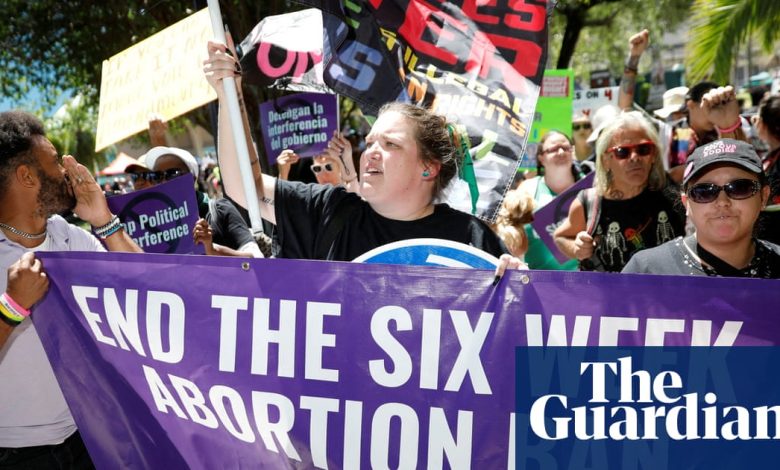Florida’s six-week abortion ban takes effect, ending access in south-east US | Florida

[ad_1]
A six-week abortion ban came into force on Wednesday in Floridacutting off access to the procedure before many people know they’re pregnant and flattening the southeastern states’ last bastion of abortion rights.
The ban went into effect weeks after the Florida state Supreme Court issued a ruling clearing the way for it to go into effect. Now strict bans cover the entire American Deep South, increasing the pressure on other clinics in the country. The closest clinic for most Florida residents after six weeks of pregnancy is now several states away in North Carolina, which bans abortion after 12 weeks of pregnancy.
Florida abortion providers performed more than 84,000 abortions last year, state data show – inclusive more than 9,000 for out-of-state patients, according to the Guttmacher Institute, which tracks abortion restrictions. Approximately 60% of abortions in Florida occurs after six weeks of pregnancy.
On Tuesday, the last day before the ban went into effect, an abortion clinic in Gainesville, Florida, was scrambling to see as many patients as possible. The clinic had extra hours throughout April, but the rush was complicated by the fact that, in addition to the impending ban, Florida requires people to have an in-person consultation at an abortion clinic at least 24 hours before getting the procedure or taking abortion pills. A patient may have arrived on Tuesday just six weeks into her pregnancy, but it was too late to have an abortion given the ban came into force on Wednesday.
In Tuesday, the all-female team of staff at the clinic, Bread and Roses Women’s Health Center, had to explain these complex regulations to confused callers and patients over and over as the phones rang non-stop for hours.
Before the six-week ban, Christine, director of Bread and Roses, said the clinic rarely saw people before they were six weeks pregnant.
“Most people don’t know they’re pregnant until at least six weeks,” Christine said in an interview a week before the ban took effect. (Citing privacy fears, like many others at the clinic, Christine asked to be identified only by her first name.) “We try to get people in as quickly as possible, but sometimes we’re booked for one or three weeks, so it’s rare for anyone to come in before they’re six weeks old.
Compared to 2020, there were nearly 9,000 more abortions in Florida in 2023. Out-of-state abortion patients accounted for nearly 60% of this increase, according to the Guttmacher Institute.
Bread and Roses used to see 20 to 30 patients a day, but in April the clinic began seeing nearly 40 patients a day, Christine said. The clinic tends to see anywhere between 3 and 10 out-of-state patients each day, she said.
“As states go down, the bigger increases we’re seeing from other states,” Christine said.
Christine declined to say where the patients at her clinic are coming from, other than to say they stretch to the southeast.
In addition to its decision last month to allow the six-week ban to go into effect, the Florida Supreme Court — which is dominated by Republican-appointed justices — greenlit a November ballot measure to enshrine abortion rights in the state constitution. If the measure passes, a six-week ban will be considered unconstitutional and abortion will be legal until viability, approximately 24 weeks into pregnancy. Multiple Bread and Roses employees wore pins urging people to “Vote Yes” for the ballot.
Roughly a dozen states may have residents vote directly on abortion rights in November. abortion rights supporters have already won elections in states across the country, including Republican strongholds like Kansas and Kentucky, but to win in Florida, the abortion rights measure would need to win 60 percent of the vote.
Regardless of its outcome, the vote is months away. Meanwhile, thousands of patients could be affected by the six-week ban.
“It’s going to be terrible and it’s going to affect the whole Southeast,” said Dr. K, a family medicine physician who performs abortions at Bread and Roses. “I just have no idea what these patients are going to do and where they’re going to go.”
[ad_2]




